
A gene as a stretch of DNA on a chromosome. Alleles as versions (sequence variants) of a gene.
- Subject:
- Biology
- Genetics
- Life Science
- Material Type:
- Lesson
- Provider:
- Khan Academy
- Provider Set:
- Khan Academy
- Author:
- Sal Khan
- Date Added:
- 12/10/2014

A gene as a stretch of DNA on a chromosome. Alleles as versions (sequence variants) of a gene.
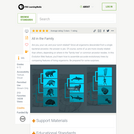
In this Evolution Web feature, test your skills at judging who's who on the tree of life while you learn about the tools and methods of cladistics.

These images from the Smithsonian Institution depict Nancy Knowlton's work with snapping shrimp in Panama. Knowlton found that the closing of the isthmus -- dividing the Pacific Ocean from the Caribbean -- resulted in new species of shrimp.

This video segment from the Secret of Life School Video: "Genetic Medicine: Tinkering with Our Genes" explores the potential for gene therapy to cure diseases like Alzheimer's.

This resource is a video abstract of a research paper created by Research Square on behalf of its authors. It provides a synopsis that's easy to understand, and can be used to introduce the topics it covers to students, researchers, and the general public. The video's transcript is also provided in full, with a portion provided below for preview:
"Glioma is the most common and lethal form of brain cancer. Among patients with the highest grade of glioma, fewer than 6% survive up to 5 years after diagnosis. Interestingly, glioma is extremely rare in one large population of patients patients with Alzheimer’s disease. That suggests that an anti-glioma molecule could play a critical role in the development of Alzheimer’s. In a recent study, researchers assessed one possible candidate: presenilin-1. Presenilin-1 is a protein that assists the formation of amyloid beta, the main component of the hallmark plaques found in the brains of patients with Alzheimer’s. Experiments showed that high presenilin-1 levels in glioma tissue from patients correlated with low tumor proliferation. Closer examination revealed that presenilin-1 kept cancer from spreading by preventing tumor cells from replicating their DNA. This mechanism could explain the poor prognosis of glioma patients with low levels of presenilin-1..."
The rest of the transcript, along with a link to the research itself, is available on the resource itself.

This resource is a video abstract of a research paper created by Research Square on behalf of its authors. It provides a synopsis that's easy to understand, and can be used to introduce the topics it covers to students, researchers, and the general public. The video's transcript is also provided in full, with a portion provided below for preview:
"There may be a silver lining for those at high risk for Alzheimer’s: as the chance of getting the disease goes up, certain treatments may become more effective. The risk of developing Alzheimer’s largely relies on a gene called APOE, with different variants conferring more or less risk. Usually, having a high-risk allele is bad news, but a group of researchers from New York University has reported that carrying the high-risk allele could actually boost responsiveness to immunotherapy, a promising new treatment option. The APOE gene helps determine how much beta-amyloid accumulates in the brain. Beta-amyloid starts as small misfolded bits of protein that clump together to form the plaques that are the hallmark of Alzheimer’s. As the plaques appear, the brain deteriorates, particularly in regions associated with memory. One way to potentially halt this process is to use antibodies that recognize beta-amyloid. The antibodies bind to the protein and signal to the immune system to clear it out..."
The rest of the transcript, along with a link to the research itself, is available on the resource itself.
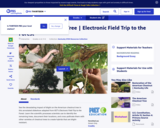
This annotated slideshow adapted from KET's Electronic Field Trip to the Forest illustrates how blight decimated the American chestnut tree and the methods scientists use to identify and pollinate the remaining trees to create blight-resistant trees.




We will explore the changing political choices and ethical dilemmas of American scientists from the atomic scientists of World War II to biologists in the present wrestling with the questions raised by cloning and other biotechnologies. As well as asking how we would behave if confronted with the same choices, we will try to understand the choices scientists have made by seeing them in their historical and political contexts. Some of the topics covered include: the original development of nuclear weapons and the bombing of Hiroshima and Nagasaki; the effects of the Cold War on American science; the space shuttle disasters; debates on the use of nuclear power, wind power, and biofuels; abuse of human subjects in psychological and other experiments; deliberations on genetically modified food, the human genome project, human cloning, embryonic stem cell research; and the ethics of archaeological science in light of controversies over museum collections.
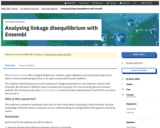
The Ensembl project offers integrated genome, variation, gene regulation and comparative genomics data of mainly vertebrate genomes on an open access web browser platform.
This webinar will introduce you to the analysis of Linkage Disequilibrium (LD) between variants with Ensembl. We will look at different ways to explore and visualise LD in the Ensembl genome browser website. We will discuss the new LD Calculator tool which has been released with Ensembl 91 and show how to use it.
Who is this course for?
This webinar is aimed at individuals who wish to learn more about analysing LD with Ensembl. No prior knowledge of bioinformatics is required, but an understanding of undergraduate level genetics would be useful.
Outcomes
By the end of the webinar you will be able to:
Analyse linkage disequilibrium between variants in Ensembl
Visualise linkage disequilibrium using the Ensembl Genome Browser

This class analyzes complex biological processes from the molecular, cellular, extracellular, and organ levels of hierarchy. Emphasis is placed on the basic biochemical and biophysical principles that govern these processes. Examples of processes to be studied include chemotaxis, the fixation of nitrogen into organic biological molecules, growth factor and hormone mediated signaling cascades, and signaling cascades leading to cell death in response to DNA damage. In each case, the availability of a resource, or the presence of a stimulus, results in some biochemical pathways being turned on while others are turned off. The course examines the dynamic aspects of these processes and details how biochemical mechanistic themes impinge on molecular/cellular/tissue/organ-level functions. Chemical and quantitative views of the interplay of multiple pathways as biological networks are emphasized. Student work culminates in the preparation of a unique grant application in an area of biological networks.

This course focuses on computational and experimental analysis of biological systems across a hierarchy of scales, including genetic, molecular, cellular, and cell population levels. The two central themes of the course are modeling of complex dynamic systems and protein design and engineering. Topics include gene sequence analysis, molecular modeling, metabolic and gene regulation networks, signal transduction pathways and cell populations in tissues. Emphasis is placed on experimental methods, quantitative analysis, and computational modeling.

This document presents the results of the Erasmus+ "InterMedia Project," focusing on the exploration of multimedia and interactivity in the context of education and learning. The first section provides an overview of multimedia, including its definition, origins, evolution, and significance in daily life. The following section delves into the concept of interactivity, defining it and highlighting its different types and importance. The document then explores the added value of multimedia and interactive learning content for learners, training providers, and adult education organizations. It emphasizes the benefits and considerations associated with different age groups of adults. The subsequent section analyses various tools used in the project, such as Animaker, Canva, Exe-learning, HTML Validator, Padlet, the H5P Framework, ThingLink, Powtoon, and W3Schools. Lastly, the document provides information about the project partners, including AJITER, EUPHORIANET, BRAINLOG, and EUROPÄISCHE BILDUNGSINITIATIVE EBI/EIE.
Overall, the Erasmus+ "InterMedia Project" offers valuable insights into the potential of multimedia and interactivity in the field of education.

This resource is a video abstract of a research paper created by Research Square on behalf of its authors. It provides a synopsis that's easy to understand, and can be used to introduce the topics it covers to students, researchers, and the general public. The video's transcript is also provided in full, with a portion provided below for preview:
"In the absence of oxygen, some prokaryotes can degrade organic matter via anaerobic digestion. This occurs in natural settings, like wetlands, and industrial ones, like wastewater treatment or biogas production. But what about viruses? Bacteriophages can impact their hosts’ community structure through selective pressure and have been used to influence microbial communities, such as through pathogen control. A recent study examined the virome of anaerobic digestion communities undergoing prophage- inducing environmental stresses. The virome was almost entirely composed of tailed bacteriophages of the order Caudovirales. Metagenome reconstruction revealed 1,092 viral genomes and 120 prokaryotic genomes, and over half of the prokaryotic genomes contained a provirus in their genomic sequence. In general, species of viruses and prokaryotes could be grouped by having similar reactions to stressors. Archaea had the most pronounced reactions to stressors and featured behaviors unique to those species..."
The rest of the transcript, along with a link to the research itself, is available on the resource itself.
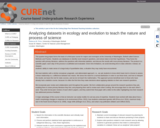
This quarter-long project forms the basis of a third-year course for majors and nonmajors at the University of Washington, Bothell called Science Methods and Practice. Students use databases to identify novel research questions, and extract data to test their hypotheses. They frame the question with primary literature, address the questions with inferential statistics, and discuss the results with more primary literature. The product is a scientific paper; each step of the process is scaffolded and evaluated. Given time limitations, we avoid devoting time to data collection; instead, we sharpen
students' ability to make sense of a large body of quantitative data, a situation they may rarely have encountered.
We treat statistics with a strictly conceptual, pragmatic, and abbreviated approach; i.e., we ask students to know which basic test to choose to assess a linear relationship vs. a difference between two means. We stress the need for a normal distribution
in order to use these tests, and how to interpret the results; we leave the rest for stats courses, and we do not teach the mathematics. This approach proves beneficial even to those who have already had a statistics course, because it is often the first time
they make decisions about applying statistics to their own research questions.
We incorporate peer review and collaborative work throughout the quarter. We form collaborative groups around the research questions they ask, enabling them to share primary literature they find, and preparing them well to review each other's writing. We encourage them to cite each other's work. They write formal peer reviews of each other's papers, and they submit their final paper with a letter-to-the-editor highlighting how their research has addressed previous feedback.
A major advantage of this course is that an instructor can easily modify it to suit any area of expertise. Students have worked with data about how a snail's morphology changes in response to its environment (Price, 2012), how students understand genetic drift (Price et al. 2014), maximum body size in the fossil record (Payne et al. 2008), range shifts (Ettinger et al. 2011), and urban crop pollination (Waters and Clifford 2014).
(Note: this resource was added to OER Commons as part of a batch upload of over 2,200 records. If you notice an issue with the quality of the metadata, please let us know by using the 'report' button and we will flag it for consideration.)

This resource is a video abstract of a research paper created by Research Square on behalf of its authors. It provides a synopsis that's easy to understand, and can be used to introduce the topics it covers to students, researchers, and the general public. The video's transcript is also provided in full, with a portion provided below for preview:
"Apoptosis is a form of cell death that occurs as part of normal development. Once considered irreversible, apoptosis might not mark the end for all cells—including cancer cells. Growing evidence suggests that cancer cells can be rescued from the brink of death through a process called anastasis, which could explain how tumors resist anticancer therapies. From the Greek for “resurrection,” anastasis can occur through a variety of mechanisms, such as by arresting the activity of caspases, enzymes in charge of dismantling the cell during apoptosis by activating DNA repair mechanisms and by allowing cell fragments to fuse and continue living even after apoptosis has begun. Further studies are needed to explore how cancer cells cheat death through anastasis and how to adjust anticancer therapies accordingly..."
The rest of the transcript, along with a link to the research itself, is available on the resource itself.
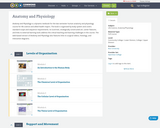
Anatomy and Physiology is a dynamic textbook for the two-semester human anatomy and physiology course for life science and allied health majors. The book is organized by body system and covers standard scope and sequence requirements. Its lucid text, strategically constructed art, career features, and links to external learning tools address the critical teaching and learning challenges in the course. The web-based version of Anatomy and Physiology also features links to surgical videos, histology, and interactive diagrams.